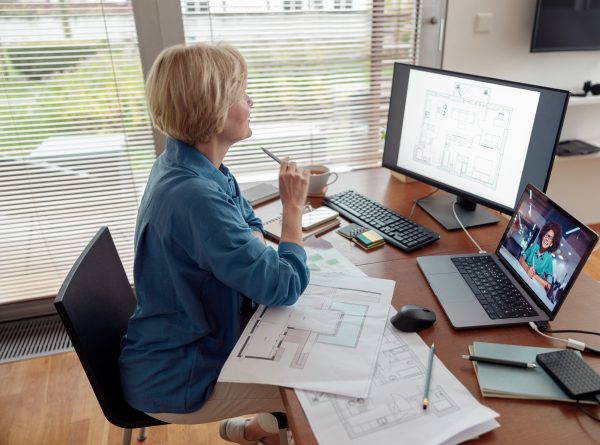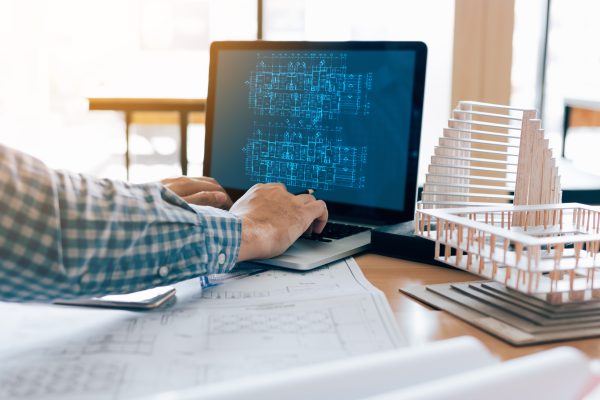A survey by Owl Labs revealed that 31% of hybrid or remote employees would consider leaving their jobs if required to return to the office full-time, while 22% would be dissatisfied with such a change. Remote work not only helps retain employees but also boosts productivity, underscoring its growing importance as a viable option for firms looking to tap into a global talent pool. Collaborating with architects from around the world offers significant benefits, including access to diverse perspectives, cost savings, and greater flexibility. However, these advantages come with the challenge of maintaining quality control with remote architects.
To ensure that remote architects consistently deliver work that meets your firm’s high standards, a strategic approach is essential—one that prioritizes clear communication, the right tools, and proactive management. In this blog, we’ll explore key strategies and best practices for ensuring quality control with remote architects to help you achieve exceptional results on every project.
6 Key Strategies to Ensure Quality Control with Remote Architects
-
Establish Clear Communication Channels

Effective communication is the foundation of successful collaboration, especially when working with remote architects. Without clear and consistent communication channels, misunderstandings and errors can easily occur, leading to delays and compromised quality.
Choose the Right Communication Tools
Select tools that facilitate real-time communication and collaboration, such as Slack, Microsoft Teams, or Zoom. These platforms allow team members to exchange ideas, share updates, and resolve issues quickly, regardless of location.
Set Expectations for Communication
Establish clear expectations for how and when communication should occur. This includes setting regular meeting times, defining response times for messages, and determining the preferred methods of communication for different types of interactions.
Document Everything
Encourage the habit of documenting important discussions, decisions, and project changes. This ensures that everyone has access to the same information and can refer back to it when needed, reducing the risk of miscommunication.
At BizForce, our architects excel in communication and responsiveness, setting them apart in the industry. We understand that effective communication is not just about using the right tools—it’s about being proactive, attentive, and fully engaged with our clients throughout every stage of the project. Our architects make it a priority to keep clients informed, addressing their questions and concerns promptly and thoroughly.
-
Define Clear Project Guidelines and Standards
To maintain quality control, it’s crucial to provide remote architects with clear guidelines and standards that outline what is expected of them. This clarity helps to ensure that their work aligns with your firm’s vision and meets the necessary quality benchmarks.
Develop a Detailed Project Brief
Create a comprehensive project brief that includes all relevant details, such as design requirements, project scope, deadlines, and quality expectations. This brief should be shared with all remote architects at the start of the project.
Provide Standardized Templates and Checklists
Offer templates, checklists, and style guides that remote architects can use to ensure consistency in their work. These resources can help to minimize errors and ensure that the work produced aligns with your firm’s standards.
Clarify Quality Expectations
Make sure that remote architects understand what quality means for your firm. This might include specific criteria related to design aesthetics, functionality, sustainability, or adherence to building codes.
-
Utilize Technology for Collaboration and Oversight

Technology plays a critical role in maintaining quality control when working with remote architects. By leveraging the right tools, you can facilitate seamless collaboration, monitor progress, and ensure that work meets your standards.
Use Collaborative Design Software
Implement software like Building Information Modeling (BIM) or Computer-Aided Design (CAD) platforms that allow multiple team members to work on the same design file simultaneously. These tools often include version control features that help maintain consistency and track changes.
Implement Project Management Tools
Utilize project management platforms like Asana, Trello, or Monday.com to assign tasks, track progress, and manage deadlines. These tools provide visibility into the project’s status and help ensure that all tasks are completed on time and to the required standard.
Leverage Cloud Storage for File Sharing
Use cloud-based storage solutions like Google Drive or Dropbox to store and share project files. This ensures that all team members have access to the most up-to-date versions of documents and designs, reducing the risk of errors caused by outdated information.
-
Conduct Regular Quality Reviews
Routine quality reviews are essential for maintaining high standards when working with remote architects. These reviews allow you to catch any issues early and ensure that the work produced aligns with your firm’s expectations.
Schedule Milestone Reviews
Plan regular check-ins at key project milestones to review the work completed so far. These reviews should assess whether the work meets the project’s design and quality criteria and identify any areas that need improvement.
Encourage Peer Reviews
Foster a culture of peer review among your remote architects. Encouraging team members to review each other’s work can help to catch mistakes and provide valuable feedback that improves the overall quality of the project.
Use Remote Monitoring Tools
Consider using software that allows you to monitor the progress of the project in real-time. Tools that offer analytics and reporting features can provide insights into how well the project is adhering to timelines, budgets, and quality standards.
-
Provide Continuous Training and Support
Even the most experienced architects can benefit from ongoing training and support, especially when working remotely. Continuous professional development ensures that remote architects stay up-to-date with industry standards and best practices, which is essential for maintaining quality control.
Offer Regular Training Sessions
Schedule regular virtual training sessions on topics such as new design software, sustainability practices, or industry trends. These sessions should be accessible to all remote architects and tailored to their specific needs.
Create a Support System
Establish a system where remote architects can easily seek help or clarification when needed. This could include assigning a mentor or creating a dedicated support channel where questions can be answered promptly.
Encourage Knowledge Sharing
Foster a culture of continuous learning by encouraging remote architects to share their knowledge and expertise with the team. This can be done through internal webinars, collaborative documents, or regular team meetings.
-
Foster a Strong Remote Work Culture
A positive remote work culture is essential for ensuring that remote architects feel motivated, engaged, and connected to the project. When team members are aligned with your firm’s values and goals, they are more likely to produce high-quality work.
Build Trust and Accountability
Encourage a culture of trust by setting clear expectations and holding everyone accountable for their work. Trust is crucial in remote environments, where micromanagement is neither feasible nor effective.
Promote Collaboration and Teamwork
Foster a sense of community among remote architects by promoting collaboration and teamwork. Regular virtual team-building activities and open communication channels can help build strong relationships.
Recognize and Reward Excellence
Regularly acknowledge and reward high-quality work. Recognition can be a powerful motivator, especially in a remote setting where team members might feel isolated.
Conclusion
Ensuring quality control with remote architects requires a strategic approach that combines clear communication, defined standards, and the right technology. By implementing these best practices, architecture firms can maintain high standards of quality while reaping the benefits of remote work. With a focus on continuous improvement and support, firms can ensure that their remote architects consistently deliver exceptional results, helping to achieve project goals and exceed client expectations.
Achieve Superior Quality Control and Project Success with BizForce’s Remote Architects

Our dedicated team combines clear communication, defined standards, and cutting-edge technology to ensure top-notch quality control from start to finish. Partner with us to experience the benefits of remote work while maintaining the highest standards of excellence. Let’s exceed your expectations together—contact us today to see how BizForce can help you achieve your project goals with ease! Click here.
